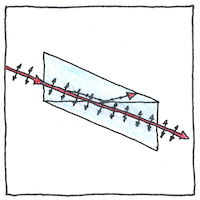William Nicol
optics

|
Nicol prism
Rasmus Bartholin understood that Iceland spar, a transparent calcite crystal, produces a double refraction, that is, birefringence. Viking navigators called these “sunstones” and used them to discern the direction of the sun on cloudy days. William Nicol constructed a prism by gluing together two pieces of Iceland spar cut at exactly 68 degrees to the crystal axis. Nicol’s prism produces a plane polarized light, correcting the refraction of the extraordinary ray and eliminating the ordinary ray by internal reflection.
Famous prisms
Isaac Newton used two triangular glass prisms to discover his theory of color. Augustin-Jean Fresnel used circular arrays of curved glass prisms to concentrate a lighthouse beam. Ignazio Porro used a double Porro prism in his prism binoculars. Giovanni Battista Donati used a double-Amici prism to observe stellar spectra. Leonard R. Ingersoll used a Nicol prism in his Glarimeter to measure paper glossiness.
Secondary qualities
What we perceive as through a sieve reflects bio-specifics more than physics.



If, by the term “color,” we mean a combined set of different frequencies of light, then we are talking about physics. But if we mean a combined sense of degrees of red, blue, and green, then we are talking about perception. Newton’s experiment was the first to pry physics from perception, and Nicol’s prism was the first to provide plane polarized light.
See also in The book of science:
Readings in wikipedia: